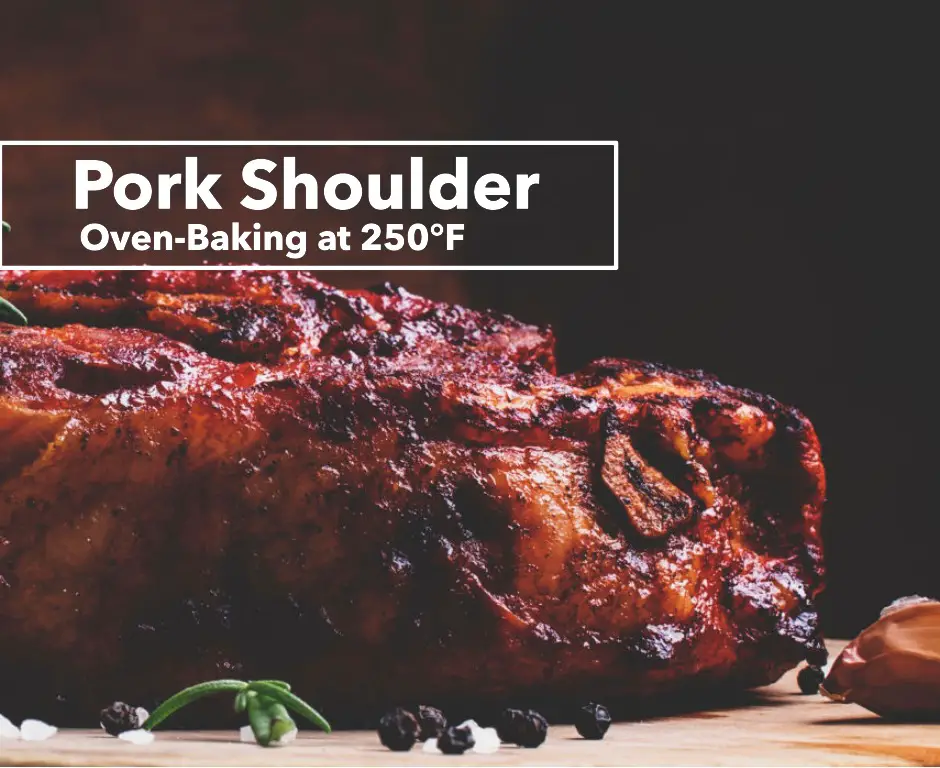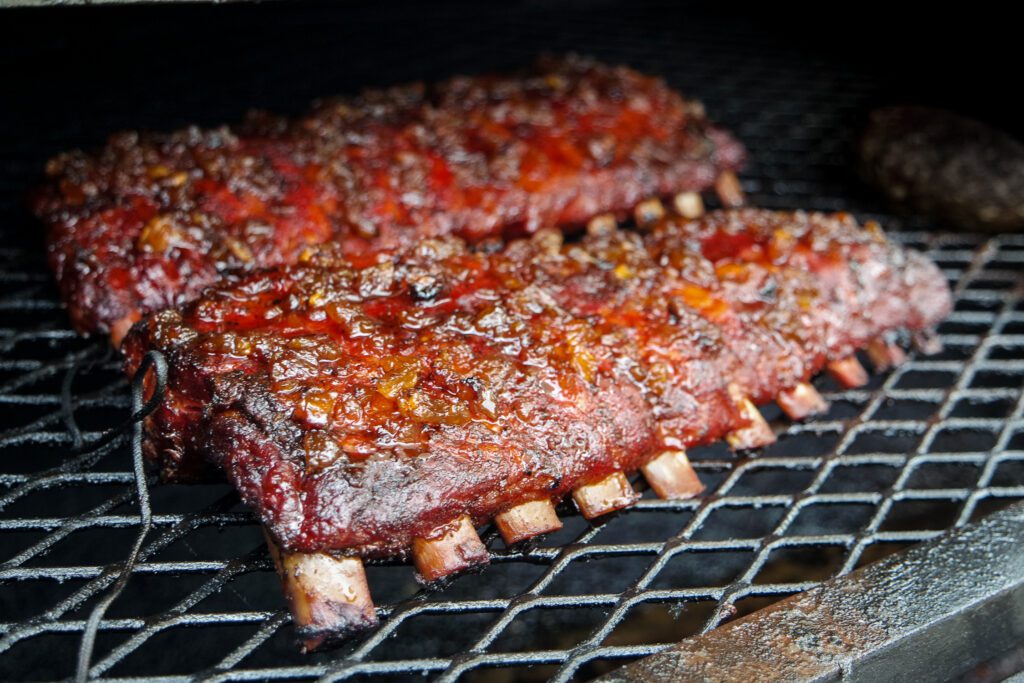Cooking pork shoulder in the oven at 250°F can be a delicious and satisfying meal for any occasion. This low and slow cooking method is ideal for breaking down the connective tissue in the pork shoulder, resulting in a juicy and tender meat that falls apart with ease. Here’s how to cook pork shoulder in oven at 250.
First, preheat your oven to 250°F. While waiting for it to heat up, prepare your pork shoulder by trimming off any excess fat or skin. Season it generously with salt and pepper or your favorite rub.
Next, place the seasoned pork shoulder on a roasting pan or wrap it tightly in foil to help retain moisture during the cooking process. Using a meat thermometer, check that the internal temperature of the pork shoulder reaches 195°F before removing it from the oven.
Cooking time will vary depending on the size of your pork shoulder. A general rule of thumb is to allow for 6-8 hours of cooking time for a medium-sized pork shoulder weighing around 4-5 pounds.
Once done, remove the cooked pork shoulder from the oven and let it rest for about 20 minutes before slicing or shredding it into servings.
To store cooked pork shoulder in oven at 250, place it in an airtight container or wrap tightly with foil and refrigerate within two hours of cooking. It can last up to four days in the refrigerator or up to six months if frozen properly.
Understanding the Cut and Best Practices for Low Temperature Cooking
Low temperature cooking is a popular method for preparing boneless cuts of pork shoulder. This technique involves cooking the meat at a low temperature for an extended period, resulting in a tender and flavorful dish. In this section, we will discuss the best practices for low temperature cooking and why it works so well.
Boneless cuts of pork shoulder are ideal for low temperature cooking as they have a high amount of connective tissue that needs to be broken down during the cooking process. By cooking the meat at low temperatures, around 250°F, for six to eight hours, the heat slowly penetrates the meat and breaks down these tissues. This results in a tender and juicy pork shoulder that is full of flavor.
To ensure even cooking, it is important to use a meat thermometer to check the internal temperature of the pork shoulder. The ideal internal temperature should be between 195°F-205°F. When using this method, it’s important not to open the oven frequently as this can cause fluctuations in temperature and affect overall cooking time.
One of the key benefits of low-temperature cooking is that it allows you to retain moisture in your pork shoulder. Because you’re not exposing your meat to high heat levels or rapid changes in heat levels throughout your cook time, there’s less chance that moisture will escape from your cut during preparation. This means that when you finally slice into your finished product, you’ll be rewarded with succulent bites full of flavor.
Preparing and Seasoning Pork Shoulder for Oven Roasting
Preheat Your Oven to 250°F
To get started on cooking your pork shoulder roast, preheat your oven to 250°F. This low temperature will allow the meat to cook slowly and evenly, resulting in a tender and juicy roast. Preheating the oven before placing the pork shoulder inside is essential for getting an accurate cooking time.
Prepare a Dry Rub for Added Flavor
A dry rub is an excellent way to add flavor to your pork shoulder roast. To make your own dry rub, combine onion powder, chili powder, and olive oil in a bowl. Mix well until all ingredients are combined. Once you have mixed up your dry rub, apply it generously over the entire surface of the pork shoulder using your hands or a brush.
Place Pork Shoulder Roast in Roasting Pan
After seasoning with a dry rub, place the seasoned pork shoulder roast into a roasting pan. This will ensure that it cooks evenly on all sides and prevents any juices from spilling out onto the bottom of the oven. You can also add vegetables like carrots, onions or potatoes around the edges of the pan for added flavor.
Roast Until Internal Temperature Reaches 195°F
The cooking time for a pork shoulder roast varies depending on its size but generally takes several hours at 250°F until it reaches an internal temperature of 195°F. Using an instant-read thermometer inserted into the thickest part of the meat ensures that it has reached this safe temperature before removing it from the oven.
Searing Pork Shoulder Before Slow Roasting
Creating a Flavorful Crust on Pork Shoulder Through Searing
Searing pork shoulder before slow roasting is an essential step in creating a flavorful crust on the meat. The high heat from searing caramelizes the surface of the pork, which creates a rich and complex flavor profile that complements the tenderness of the slow-roasted interior.
To sear your pork shoulder, heat up a large skillet or Dutch oven over medium-high heat with oil until it shimmers. Pat dry your pork shoulder with paper towels to ensure that it browns evenly, then season it generously with salt and pepper. Place the pork shoulder into the hot pan and let it cook for about 3-4 minutes on each side until golden brown.
Slow Roasting Pork Shoulder at 250 Degrees Fahrenheit
Slow roasting pork shoulder at 250 degrees Fahrenheit ensures that the meat is cooked evenly and remains tender. This low-and-slow cooking method breaks down collagen and connective tissue in the meat, resulting in succulent pulled pork that melts in your mouth.
Roasting Uncovered for Depth of Flavor
Roasting the pork shoulder uncovered allows for the exterior to brown and caramelize, adding depth to its flavor profile. The Maillard reaction occurs when amino acids react with reducing sugars at high temperatures, causing browning and developing umami flavors. By leaving your roast uncovered while it cooks, you allow air circulation around all sides of the meat, enabling an even browning effect.
Using a Meat Thermometer to Check Roast Registers Internal Temperature
Using a meat thermometer to check if your roast registers an internal temperature of 195-205 degrees Fahrenheit ensures that your pork shoulder is fully cooked and ready to be pulled apart. Inserting a thermometer into several spots within different parts of your roast will help guarantee accuracy.
Allowing Your Pork Shoulder to Rest After Roasting
Allowing your pork shoulder to rest for at least 15 minutes after roasting is essential. This step allows the juices to redistribute throughout the meat, resulting in a more succulent final product. Cover your roast with foil and let it rest on a cutting board or baking sheet before pulling it apart.
Cooking Time Guide for Pork Shoulder in Oven at 250°F
Pork shoulder is a popular cut of meat that can be cooked in various ways. One of the most common methods is to cook it slowly in the oven at a low temperature. This method allows the pork shoulder to become tender and juicy, making it perfect for pulled pork sandwiches or other dishes.
A pork shoulder weighing 4-6 pounds should be cooked in the oven at 250°F for 4-5 hours. Cooking times may vary depending on the size and thickness of the pork shoulder, so it’s important to use a meat thermometer to ensure that the internal temperature reaches at least 145°F before removing it from the oven. This will ensure that any harmful bacteria are destroyed and that the pork is safe to eat.
Marinating the pork shoulder overnight before cooking it in the oven can add extra flavor and tenderness to your dish. A simple marinade could include ingredients such as soy sauce, brown sugar, garlic, and Worcestershire sauce. Be sure to pat dry any excess marinade before placing it in the oven.
To achieve a crispy exterior on your pork shoulder, you can increase the oven temperature to 400°F for the last 15-20 minutes of cooking or broil it for a few minutes. This will give your dish an added texture and flavor that will make it even more delicious.
Using a Meat Thermometer to Ensure Proper Cooking
Meat thermometers are essential tools for ensuring that your pork shoulder is cooked to perfection. With the right temperature, you can achieve a juicy and flavorful meal that’s sure to delight your taste buds. In this section, we’ll discuss how to use a meat thermometer to ensure proper cooking.
Allow the Meat to Rest at Room Temperature
Before cooking your pork shoulder, it’s essential to allow the meat to rest at room temperature for 30 minutes to an hour. This step ensures even cooking throughout the meat. If you cook cold meat straight from the fridge, it may take longer than usual since you have to factor in the time required for the cold meat’s internal temperature to rise.
Inserting the Thermometer
When using a meat thermometer, insert it into the thickest part of the pork shoulder without touching any bones or fat. The thermometer should read an internal temperature of 195°F when done correctly. It’s crucial not only to check one point but several points on different parts of the pork shoulder as some areas may cook faster than others.
Basting and Monitoring Cooking Times
While cooking your pork shoulder in an oven set at a consistent temperature of 250°F, baste it with its juices every hour. Basting helps keep moisture inside and creates a delicious crust on top of your roast. It also adds flavor and helps distribute heat evenly throughout the roast.
Monitoring cooking times is important because overcooking can lead to dryness while undercooking can cause foodborne illness. Therefore, invest in a good quality thermometer that reads quickly and accurately so that you don’t have any guesswork involved when checking if your meal is ready.
Tips and Tricks for Achieving Tender and Flavorful Pork Shoulder
Pound Pork Shoulder: The Secret to Evenly Cooked and Tender Meat
One of the simplest tips to achieve delicious pork shoulder is by pounding it before cooking. This technique helps even out the thickness of the meat, ensuring that it cooks evenly. Pounding breaks down the connective tissues in the meat, resulting in a more tender texture. To pound pork shoulder, place it between two sheets of plastic wrap and use a meat mallet or rolling pin to gently flatten it until it reaches an even thickness.
Boneless Pork Shoulder: Easier to Handle and Cook
Traditional pork shoulder with bones can be challenging to handle and cook due to its size and uneven shape. Boneless pork shoulders are easier to work with as they have a uniform shape and size. They also cook faster than bone-in pork shoulder since there is no bone blocking the heat from reaching all parts of the meat.
Pork Butt: A Great Alternative to Pork Shoulder
If you’re looking for an alternative cut of meat that has similar texture and flavor as pork shoulder, try using pork butt. Also known as Boston butt, this cut comes from the upper part of the pig’s shoulder and is perfect for slow-cooking methods like smoking or roasting.
Adding Flavor with Dry Rubs or Marinades
To add extra flavor and tenderize your pork shoulder before cooking, consider using a dry rub or marinade. A dry rub consists of herbs, spices, salt, sugar, and other seasonings that are rubbed onto the surface of the meat before cooking. On the other hand, marinades are made up of acidic ingredients like vinegar or citrus juice that help break down tough muscle fibers in the meat while infusing flavors into it.
Low-and-Slow Cooking at 250 Degrees Fahrenheit
The best way to achieve tender and flavorful pork shoulder is by cooking it low-and-slow at 250 degrees Fahrenheit. This method allows enough time for collagen to break down into gelatin, resulting in a tender texture. It also gives the meat enough time to absorb the flavors of any seasoning or marinade used.
Resting After Cooking
After cooking, it’s essential to let your pork shoulder rest for at least 20 minutes before slicing. This allows the juices to redistribute throughout the meat, resulting in a more tender and juicy final product. Cover the pork with foil and let it rest on a cutting board or serving platter.
Resting and Carving the Cooked Pork Shoulder
Letting Your Pork Shoulder Rest
After cooking your pork shoulder, it is essential to let it rest for at least 20 minutes before carving. This resting period allows the juices inside the meat to redistribute evenly throughout the cut, ensuring that every slice is tender and juicy. If you skip this step, you risk losing all those delicious juices as they seep out of the meat when you cut into it.
To rest your pork shoulder, remove it from the oven and place it on a cutting board or other flat surface. Cover it loosely with foil to keep it warm while you wait for the juices to settle. After 20 minutes have passed, remove the foil and get ready to carve.
Carving Your Pork Shoulder
Using a sharp carving knife, begin slicing your pork shoulder against the grain into thin slices. Cutting against the grain ensures that each slice will be tender and easy to chew. Be sure to use a sawing motion rather than pressing down too hard with your knife.
If you’re working with a bone-in pork shoulder, be careful not to cut too close to the bone as this can make carving more difficult. Boneless cuts are easier to work with and can be sliced more evenly than their bone-in counterparts.
Drying Your Cooked Pork Shoulder
Once you’ve finished carving your pork shoulder, place each slice on a drying rack or dish lined with paper towels. This step allows any excess marinade or juices from cooking to drip off before serving.
Serving Your Pork Shoulder
Pork shoulder makes an excellent main course for any meal and pairs well with many different side dishes. Roasted vegetables like carrots or potatoes make an excellent accompaniment, as do mashed potatoes or rice pilaf.
Leftover Pork Shoulder Storage
If you have leftover pork shoulder after your meal, store it in an airtight container in the refrigerator for up to four days. You can also freeze cooked pork shoulder for up to three months. When you’re ready to eat it, simply thaw it in the refrigerator overnight and reheat in the oven or microwave.
Recipe: Fall-Apart Roasted Pork Shoulder with Rosemary, Mustard, and Garlic
Perfect for Feeding a Crowd: A 4-Pound Pork Roast
Looking for a recipe that can feed a crowd or provide leftovers for the week? Look no further than this fall-apart roasted pork shoulder with rosemary, mustard, and garlic. This recipe calls for a 4-pound pork roast, making it perfect for family gatherings or meal prep.
The succulent pork is slow-roasted in the oven at 250 degrees until it reaches an internal temperature of 195-200 degrees. This low and slow cooking method ensures that the pork is cooked to perfection and falls apart easily when pulled.
Creating Delicious Flavor with Rosemary, Mustard, and Garlic Powder
One of the best things about this recipe is how easy it is to create delicious flavor with just a few simple ingredients. The combination of rosemary, mustard, and garlic powder creates a mouthwatering flavor profile that pairs perfectly with the succulent pork.
To make the dish even more flavorful, consider adding other herbs and spices like thyme or paprika. You can also experiment with different types of mustard or add some heat with red pepper flakes.
Serving Suggestions: Roasted Potatoes and Vegetables
This fall-apart roasted pork shoulder pairs perfectly with roasted potatoes and vegetables. Simply toss your favorite root vegetables like carrots, parsnips, or sweet potatoes in olive oil and seasonings like salt, pepper, and thyme before roasting them alongside the pork.
If you’re looking to take this dish to the next level, consider making your own homemade sauce using paprika and other spices. Alternatively, you can drizzle BBQ sauce over the juicy piece of pork for added flavor.
Mastering the Art of Cooking Perfect Pork Shoulder in Oven at 250°F
Cooking pork shoulder to perfection requires a combination of patience, technique, and attention to detail. With the right approach, you can achieve juicy, tender meat with a crispy exterior that will leave your taste buds singing.
Understanding the cut and best practices for low temperature cooking is crucial which means it requires a slow and steady cook time to break down those tough fibers and render out the fat. Preparing and seasoning the pork shoulder before oven roasting is also important. You want to infuse flavor into the meat by using herbs, spices, or marinades that complement its natural sweetness.
Searing the pork shoulder before slow roasting can help create a crust on the surface of the meat that adds texture and flavor. Once you’ve seared it on all sides, place it in a roasting pan or Dutch oven with some liquid like broth or wine to keep it moist during cooking.
Plan for about 6-8 hours depending on the size of your cut. Using a meat thermometer is essential to ensure proper cooking. Insert it into the thickest part of the meat without touching bone or fat. The internal temperature should reach 195-205°F for optimal tenderness.
Tips and tricks for achieving tender and flavorful pork shoulder include basting with its own juices periodically during cooking, adding aromatics like garlic or onions to infuse more flavor into the dish, and letting it rest after taking it out of the oven so that juices redistribute throughout.
With this fall-apart roasted pork shoulder recipe featuring rosemary, mustard, and garlic as your guidepost – you’re sure to impress anyone who takes a bite! Don’t forget about carving once cooked though: slice against grain and serve with your favorite sides.



0 Comments